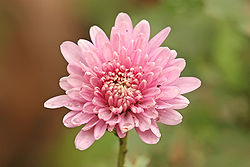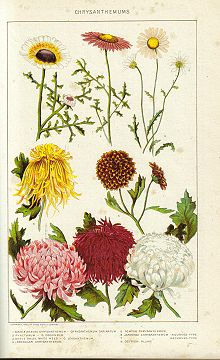Contents |
Etymology
The name Chrysanthemum is derived from the Greek, chrysos (gold) and anthos (flower).[1]Taxonomy
The genus once included a larger number of species, but was split several decades ago into several genera. The naming of the genera has been contentious, but a ruling of the International Code of Botanical Nomenclature in 1999 resulted in the defining species of the genus being changed to Chrysanthemum indicum, thereby restoring the economically important florist's chrysanthemum to the genus Chrysanthemum. During the period between the splitting of the genus and the ICBN ruling, these species have customarily been included under the genus name Dendranthema.The other species previously included in the narrow view of the genus Chrysanthemum are now transferred to the genus Glebionis. The other genera separate from Chrysanthemum include Argyranthemum, Leucanthemopsis, Leucanthemum, Rhodanthemum, and Tanacetum.
Chrysanthemum are herbaceous perennial plants growing to 50–150 cm tall, with deeply lobed leaves with large flower heads that are generally white, yellow or pink in the wild and are the preferred diet of larvae of certain lepidoptera species — see list of Lepidoptera that feed on chrysanthemums.
History
Chrysanthemums were first cultivated in China as a flowering herb as far back as the 15th century BC.[2] An ancient Chinese city (Xiaolan Town of Zhongshan City) was named Ju-Xian, meaning "chrysanthemum city". The plant is particularly significant during the Double Ninth Festival. It is believed that the flower may have been brought to Japan in the 8th century CE[citation needed], and the Emperor adopted the flower as his official seal. There is a "Festival of Happiness" in Japan that celebrates the flower.The flower was brought to Europe in the 17th century[citation needed]. Linnaeus named it from the Greek word χρυσός chrysous, "golden" (the colour of the original flowers), and ἄνθεμον -anthemon, meaning flower.
Economic uses
| | This article's tone or style may not be appropriate for Wikipedia. Specific concerns may be found on the talk page. See Wikipedia's guide to writing better articles for suggestions. (September 2010) |
| | This article may be confusing or unclear to readers. Please help clarify the article; suggestions may be found on the talk page. (September 2010) |
Ornamental uses
Modern chrysanthemums are much more showy than their wild relatives. The flowers occur in various forms, and can be daisy-like, decorative, pompons or buttons. This genus contains many hybrids and thousands of cultivars developed for horticultural purposes. In addition to the traditional yellow, other colors are available, such as white, purple, and red. The most important hybrid is Chrysanthemum × morifolium (syn. C. × grandiflorum), derived primarily from C. indicum but also involving other species.Chrysanthemums are broken into two basic groups, Garden Hardy and Exhibition. Garden hardy mums are new perennials capable of being wintered over in the ground in most northern latitudes. Exhibition varieties are not usually as sturdy. Garden hardies are defined by their ability to produce an abundance of small blooms with little if any mechanical assistance (i.e., staking) and withstanding wind and rain. Exhibition varieties on the other hand require staking, over-wintering in a relatively dry cool environment, sometimes with the addition of night lights.
The Exhibition varieties can be used to create many amazing plant forms; Large disbudded blooms, spray forms, as well as many artistically trained forms, such as: Thousand Bloom, Standard (trees), Fans, Hanging Baskets, Topiary, Bonsai, and Cascades.
Chrysanthemum blooms are divided into 13 different bloom forms by the US National Chrysanthemum Society, Inc., which is in keeping with the international classification system. The bloom forms are defined by the way in which the ray and disk florets are arranged.
Chrysanthemum blooms are composed of many individual flowers (florets), each one capable of producing a seed. The disk florets are in the center of the bloom head, and the ray florets are on the perimeter. The ray florets are considered imperfect flowers, as they only possess the female productive organs, while the disk florets are considered perfect flowers as they possess both male and female reproductive organs.
Irregular Incurve: These are the giants of the chrysanthemum world. Quite often disbudded to create a single giant bloom (ogiku), the disk florets are completely concealed, while the ray florets curve inwardly to conceal the disk and also hang down to create a 'skirt'.
Reflex: The disk florets are concealed and the ray florets reflex outwards to create a mop like appearance.
Regular Incurve: Similar to the irregular incurves, only usually smaller blooms, with nearly perfect globular form. Disk florets are completely concealed. They used to be called 'Chinese'.
Decorative: Similar to reflex blooms without the mop like appearance. Disk florets are completely concealed, ray florets usually don't radiate at more than a 90 degree angle to the stem.
Intermediate Incurve: These blooms are in-between the Irregular and Regular incurves in both size and form. They usually have broader florets and a more loosely composed bloom. Again, the disk florets are completely concealed.
Pompon: *Note the spelling, it is not pompom. The blooms are fully double, of small size, and almost completely globular in form.
Single/Semi-Double: These blooms have completely exposed disk florets, with between 1 and 7 rows of ray florets, usually radiating at not more than a 90 degree angle to the stem.
Anemone: The disk florets are prominently featured, quite often raised and overshadowing the ray florets.
Spoon: The disk florets are visible and the long tubular ray florets are spatulate.
Quill: The disk florets are completely concealed, and the ray florets are tube like.
Spider: The disk florets are completely concealed, and the ray florets are tube like with hooked or barbed ends, hanging loosely around the stem.
Brush & Thistle: The disk florets may be visible. The ray florets are often tube like, and project all around the flower head, or project parallel to the stem.
Exotic: These blooms defy classification as they possess the attributes of more than one of the other twelve bloom types.
Chrysanthemum leaves resemble its close cousin, the mugwort weed — so much so that mugwort is sometimes called wild chrysanthemum — making them not always the first choice for professional gardeners.
Culinary uses
Yellow or white chrysanthemum flowers are boiled to make a sweet drink in some parts of Asia. The resulting beverage is known simply as "chrysanthemum tea" (菊花茶, pinyin: júhuā chá, in Chinese). Chrysanthemum tea has many medicinal uses, including an aid in recovery from influenza. In Korea, a rice wine flavored with chrysanthemum flowers is called gukhwaju (국화주).photo 1photo 2Chrysanthemum leaves are steamed or boiled and used as greens, especially in Chinese cuisine. Other uses include using the petals of chrysanthemum to mix with a thick snake meat soup (蛇羹) in order to enhance the aroma.
Insecticidal uses
Pyrethrum (Chrysanthemum [or Tanacetum] cinerariaefolium) is economically important as a natural source of insecticide. The flowers are pulverized, and the active components called pyrethrins, contained in the seed cases, are extracted and sold in the form of an oleoresin. This is applied as a suspension in water or oil, or as a powder. Pyrethrins attack the nervous systems of all insects, and inhibit female mosquitoes from biting. When not present in amounts fatal to insects, they still appear to have an insect repellent effect. They are harmful to fish, but are far less toxic to mammals and birds than many synthetic insecticides, except in consumer airborne backyard applications. They are non-persistent, being biodegradable and also breaking down easily on exposure to light. They are considered to be amongst the safest insecticides for use around food. (Pyrethroids are synthetic insecticides based on natural pyrethrum, e.g., permethrin.Environmental uses
Chrysanthemum plants have been shown to reduce indoor air pollution by the NASA Clean Air Study.[3]Medicinal uses
Extracts of Chrysanthemum plants (stem and flower) have been shown to have a wide variety of potential medicinal properties, including anti-HIV-1,[4][5] antibacterial[6] and antimycotic.[7]| | |||
Cultural significance and symbolism
In some countries of Europe (e.g., France, Italy, Spain, Poland, Croatia), chrysanthemums are symbolic of death and are only used for funerals or on graves - similarly, in China, Japan and Korea, white chrysanthemums are symbolic of lamentation and/or grief. In some other countries, it represents honesty.[8] In the United States, the flower is usually regarded as positive and cheerful.[9]| Chrysanthemum Crest on the Japanese battleship Mikasa | Chrysanthemum Crest The gate of Yasukuni shrine |
China
- The chrysanthemum is one of the "Four Gentlemen" (四君子) of China (the others being the plum blossom, the orchid, and bamboo). The chrysanthemum is said to have been favored by Tao Qian, an influential Chinese poet, and is symbolic of nobility. It is also one of the four symbolic seasonal flowers.
- A Chrysanthemum Festival is held each year in Tongxiang, near Hangzhou, China.[10]
- Chrysanthemums are the topic in hundreds of poems of China.[11]
- The "golden flower" referred to in the 2006 movie Curse of the Golden Flower is a chrysanthemum.
- "Chrysanthemum Gate" (jú huā mén 菊花门) is taboo slang meaning "anus" (with sexual connotations). [12]
- Chrysanthemums were first cultivated in China as a flowering herb as far back as the 15th century BC.[1]
- An ancient Chinese city (Xiaolan Town of Zhongshan City) was named Ju-Xian, meaning "chrysanthemum city".
- The plant is particularly significant during the Double Ninth Festival.
Japan
- The Chrysanthemum Throne is the name given to the position of Japanese emperor.
- Chrysanthemum crest (菊花紋章, kikukamonshō or kikkamonshō) is a general term for a mon of chrysanthemum blossom design; there are more than 150 different patterns. The Imperial Seal of Japan is a particularly notable one; it is used by members of the Japanese Imperial family. There are also a number of formerly state-endowed shrines (官国弊社, kankokuheisha) which have adopted a chrysanthemum crest, most notably Tokyo's Yasukuni Shrine.[13]
- The Supreme Order of the Chrysanthemum is a Japanese honor awarded by the emperor.
- The city of Nihonmatsu, Japan hosts the "Nihonmatsu Chrysanthemum Dolls Exhibition" every autumn in historical ruin of Kasumigajo castle.[14]
- In Imperial Japan, small arms were required to be stamped with the Imperial Chrysanthemum as they were considered the personal property of the Emperor.
- The Chrysanthemum is also considered to be the seasonal flower of September.
United States
- The chrysanthemum is the flower of the American musician fraternity Phi Mu Alpha Sinfonia.
- Chrysanthemums were recognized as the official flower of the city of Chicago in 1961.[15]
- Chrysanthemums are the official flower of the city of Salinas, CA
- The Rock band Everclear has a song named after the flower.
- The Punk rock band Strung Out references the flower in the song Lucifermotorcade.
Australia
- Australians traditionally give their mother a bunch of chrysanthemums on Mother's Day.
Germany
- Industrial musicians Einstürzende Neubauten base their song blume around the flower.
Others
- The white chrysanthemum is the flower of Triangle Fraternity, a society of engineers, architects, and scientists.
- The term "chrysanthemum" is also used to refer to a certain type of firework shell that produces a pattern of trailing sparks similar to a chrysanthemum flower.[citation needed]
- The chrysanthemum is also the flower of November.[16]




















No comments:
Post a Comment